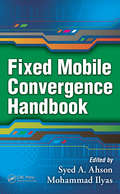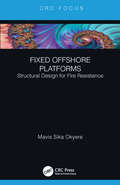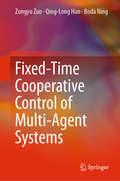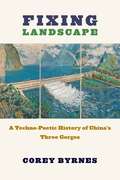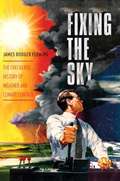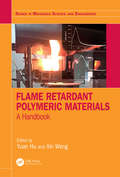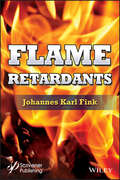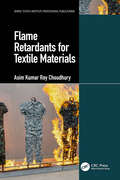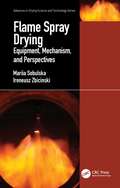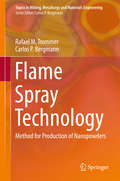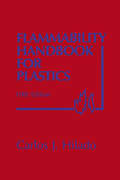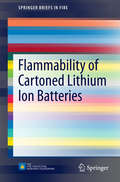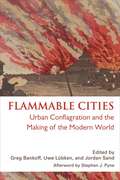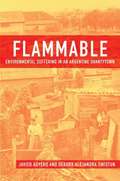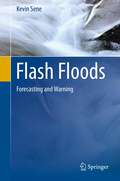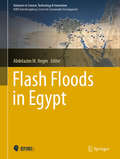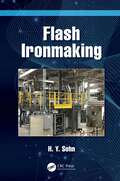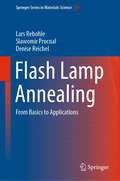- Table View
- List View
Fixed Mobile Convergence Handbook
by Mohammad Ilyas Syed A. AhsonRequirements for next generation networks (NGNs) are fueling an architectural evolution. Service providers are obliged to give users access to content anytime, anyhow, anywhere, on any device. This requires a converged infrastructure in which users across multiple domains can be served through a single unified domain and all network services and business units can be consolidated on a single IP infrastructure. The Fixed Mobile Convergence Handbook is a comprehensive guide to the design, implementation, and management of converged cellular/WiFi wireless networks. This book discusses how FMC is transforming technologies as multimedia ceases to be passively consumed and unidirectional—and becomes increasingly mobile, personalized and interactive. This book also describes ways to ensure that networks remain cost-effective, scalable, reliable, and secure in the face of constant technological evolution. This material encapsulates the state of FMC, covering everything from basic concepts to research-grade material and future directions. Addressing a broad range of topics, the handbook consists of 16 chapters authored by 44 experts from around the world. Subjects include: Femtocell network technology and applications Deployment modes and interference avoidance Architecture for power efficiency Conversational quality and network planning Design of SIP-based mobility management protocols Highly respected in their field, the authors anticipate the key issues and problems that FMC presents—from application inception and deployment to system interconnection and Quality of Service (QoS). Ideal for professional mobile technology designers and/or planners, researchers (faculty members and graduate students), this book provides specific salient features and information that will guide innovation in the 21st century and beyond. Syed Ahson is a senior software design engineer with Microsoft. Previously, he was a senior staff software engineer with Motorola, where he was a leading contributor in the creation of several iDEN, CDMA, and GSM cellular phones. Dr. Mohammad Ilyas is associate dean for research and industry relations at the College of Engineering and Computer Science at Florida Atlantic University, Boca Raton. A consultant to several national and international organizations, Dr. Ilyas is a member of both the IEEE and ASEE.
Fixed Offshore Platforms:Structural Design for Fire Resistance
by Mavis Sika OkyereThis book examines the fire-resistant design of fixed offshore platforms. It describes the required loading, load combinations, strength and stability checks for structural elements. It also explains the design of tubular joints, fatigue analysis, dynamic analysis, and impact analysis, Fire resistance, fire, explosion and blast effect analysis, fire protection materials, and safety.
Fixed-Time Cooperative Control of Multi-Agent Systems
by Qing-Long Han Zongyu Zuo Boda NingThis monograph presents new theories and methods for fixed-time cooperative control of multi-agent systems. Fundamental concepts of fixed-time stability and stabilization are introduced with insightful understanding. This book presents solutions for several problems of fixed-time cooperative control using systematic design methods. The book compares fixed-time cooperative control with asymptotic cooperative control, demonstrating how the former can achieve better closed-loop performance and disturbance rejection properties. It also discusses the differences from finite-time control, and shows how fixed-time cooperative control can produce the faster rate of convergence and provide an explicit estimate of the settling time independent of initial conditions. This monograph presents multiple applications of fixed-time control schemes, including to distributed optimization of multi-agent systems, making it useful to students, researchers and engineers alike.
Fixing Landscape: A Techno-Poetic History of China’s Three Gorges (Studies of the Weatherhead East Asian Institute, Columbia University)
by Corey ByrnesIn 1994, workers broke ground on China’s Three Gorges Dam. By its completion in 2012, the dam had transformed the ecology of the Yangzi River, displaced over a million people, and forever altered a landscape immortalized in centuries of literature and art. The controversial history of the dam is well known; what this book uncovers are its unexpected connections to the cultural traditions it seems to sever. By reconsidering the dam in relation to the aesthetic history of the Three Gorges region over more than two millennia, Fixing Landscape offers radically new ways of thinking about cultural and spatial production in contemporary China.Corey Byrnes argues that this monumental feat of engineering can only be understood by confronting its status as a techno-poetic act, a form of landscaping indebted to both the technical knowledge of engineers and to the poetic legacies of the Gorges as cultural site. Synthesizing methods drawn from premodern, modern, and contemporary Chinese studies, as well as from critical geography, art history, and the environmental humanities, Byrnes offers innovative readings of eighth-century poetry, paintings from the twelfth through twenty-first centuries, contemporary film, nineteenth-century British travelogues, and Chinese and Western maps, among other sources. Fixing Landscape shows that premodern poetry and visual art have something urgent to tell us about a contemporary experiment in spatial production. Poems and paintings may not build dams, but Byrnes argues that the Three Gorges Dam would not exist as we know it without them.
Fixing the Sky
by Fleming James RodgerAs alarm over global warming spreads, a radical idea is gaining momentum. Forget cuts in greenhouse gas emissions, some scientists argue. Instead, bounce sunlight back into space by pumping reflective nanoparticles into the atmosphere. Launch mirrors into orbit around the Earth. Make clouds thicker and brighter to create a "planetary thermostat. "These ideas might sound like science fiction, but in fact they are part of a very old story. For more than a century, scientists, soldiers, and charlatans have tried to manipulate weather and climate, and like them, today's climate engineers wildly exaggerate what is possible. Scarcely considering the political, military, and ethical implications of managing the world's climate, these individuals hatch schemes with potential consequences that far outweigh anything their predecessors might have faced. Showing what can happen when fixing the sky becomes a dangerous experiment in pseudoscience, James Rodger Fleming traces the tragicomic history of the rainmakers, rain fakers, weather warriors, and climate engineers who have been both full of ideas and full of themselves. Weaving together stories from elite science, cutting-edge technology, and popular culture, Fleming examines issues of health and navigation in the 1830s, drought in the 1890s, aircraft safety in the 1930s, and world conflict since the 1940s. Killer hurricanes, ozone depletion, and global warming fuel the fantasies of today. Based on archival and primary research, Fleming's original story speaks to anyone who has a stake in sustaining the planet.
Fixing the Sky: The Checkered History of Weather and Climate Control (Columbia Studies in International and Global History)
by James FlemingAs alarm over global warming spreads, a radical idea is gaining momentum. Forget cuts in greenhouse gas emissions, some scientists argue. Instead, bounce sunlight back into space by pumping reflective nanoparticles into the atmosphere. Launch mirrors into orbit around the Earth. Make clouds thicker and brighter to create a "planetary thermostat."These ideas might sound like science fiction, but in fact they are part of a very old story. For more than a century, scientists, soldiers, and charlatans have tried to manipulate weather and climate, and like them, today's climate engineers wildly exaggerate what is possible. Scarcely considering the political, military, and ethical implications of managing the world's climate, these individuals hatch schemes with potential consequences that far outweigh anything their predecessors might have faced.Showing what can happen when fixing the sky becomes a dangerous experiment in pseudoscience, James Rodger Fleming traces the tragicomic history of the rainmakers, rain fakers, weather warriors, and climate engineers who have been both full of ideas and full of themselves. Weaving together stories from elite science, cutting-edge technology, and popular culture, Fleming examines issues of health and navigation in the 1830s, drought in the 1890s, aircraft safety in the 1930s, and world conflict since the 1940s. Killer hurricanes, ozone depletion, and global warming fuel the fantasies of today. Based on archival and primary research, Fleming's original story speaks to anyone who has a stake in sustaining the planet.
Flame Propagation Fundamentals: Applications to Sustainable Fuels
by Andrés Armando Mendiburu ZevallosThis book presents the basics of flame propagation, emphasizing the combustion of ethanol, hydrogen, and ammonia, which are fuels that could make combustion sustainable. Its eight chapters cover fundamentals such as thermodynamics of combustion, chemical kinetics, conservation equations, premixed flames, flame dynamics, compressible flow, detonations, and flammability limits. The book emphasizes important theoretical developments of flame propagation fundamentals and the significance of biofuels and alternative fuels with practical examples using ethanol, hydrogen, or ammonia, making the content directly applicable to real-world scenarios. Advanced undergraduate and graduate students, researchers, and practicing engineers in combustion, sustainable energy, transport phenomena, thermodynamics, and related fields will welcome this fundamental and practical textbook.
Flame Retardant Polymeric Materials: A Handbook (Series in Materials Science and Engineering)
by Yuan Hu and Xin WangFlame Retardant Polymeric Materials provides a comprehensive and up-to-date overview of the field, from basic properties and mechanisms of action for flame retardants to emerging methods, materials, and industrial applications. With over 120 black and white images, Hu and Wang cover the latest in the development of novel polymer nanocomposites such as graphene, CNTs, LDHs, POSS, and techniques such as layer-by-layer assembly. These expert authors also include discussions on the important flame-retardant systems based on phosphorus, silicon, and boron. In doing so, they highlight the use of flame-retardants in varying industries, for example, construction, textiles, and aviation. This comprehensive handbook is an essential read for students and academics of physics with a particular interest in flame-retardant materials. It would also be recommended for professionals within the materials science and engineering fields.
Flame Retardants
by Johannes Karl FinkThis book focuses on the chemistry and applications of flame retardants for polymers and other materials. It starts with a description and types of flame retardants, as well as their properties and chemical structures, to include chlorine- and bromine-containingflame retardants, phosphorus-based flame retardants, nitrogen-based flame retardants, and silicones. Inorganic materials that serve as flame retardants, such as boron-based additives, graphenes, and others are discussed in detail.In addition, the following subjects are discussed in detail: Flame retardant polymers The mechanisms of flame retardants, such as flam
Flame Retardants
by P. M. Visakh Yoshihiko AraoThis book summarizes comprehensively many recent technical research accomplishments in the area of flame retardant research. It presents mainly flame retardant studies of polymer blends, composites and nano composites such as rubber, thermosets and thermoplastics. This book discusses different types of flame retardant using in polymers especially nano composites, as well as the role and chemistry. Leading researchers from industry, academy, government and private research institutions across the globe contribute to this book. Academics, researchers, scientists, engineers and students in research and development will benefit from an application-oriented book that helps them to find solutions to both fundamental and applied problems.
Flame Retardants for Textile Materials (Textile Institute Professional Publications)
by Asim Kumar ChoudhuryThis book focuses on flame retardants (FR) for textile materials. It discusses basics of flame retardancy and flammability and covers various types of flame retardants and materials, including natural FRs, halogen, phosphorous, and nanomaterial-based FRs. This book also discusses methods of applications of FRs and discusses FRs and the environment. Covers a variety of interdisciplinary applications in the textile industry Emphasizes environmental aspects Reports on a large number of FR compounds studied globally Discusses in detail recent developments in halogen-free eco-friendly flame retardants Extensively describes basic aspects of flame retardancy and their measurements Aimed at the practitioner and textile engineering professional this work aims to ensure development of safe textile materials for various uses, including apparel, protective wear, floor coverings, upholstery, drapery, and others.
Flame Spray Drying: Equipment, Mechanism, and Perspectives (Advances in Drying Science and Technology)
by Mariia Sobulska Ireneusz ZbicinskiDrying processes are among the most energy-consuming operations in industry. Flame spray drying (FSD) is a novel approach to reduce the energy supply needed for the spray drying process. Flame Spray Drying: Equipment, Mechanism, and Perspectives describes FSD technology and current developments in flame techniques and evaluates potential industrial implementation. Details advantages of FSD in terms of energy consumption and reduced drying time Promotes applications of biofuels for the drying process Analyzes the FSD method from CFD modelling to product quality Evaluates potential safety and product degradation risks Provides examples of potential applications of the FSD technique in drying of different materials This book describes an important new technique that is useful to chemical and process engineering researchers, professionals, and students working with drying technologies.
Flame Spray Technology
by Rafael M. Trommer Carlos P. BergmannThis book presents a complete and updated overview of Flame Spray process, from its History to the Apparatus necessary for the synthesis of nanostructures. It addresses not only the materials produced by this technique, but also their properties, such as crystallinity and crystallite size, specific surface area, particle size and morphology. Also, the principles of nanoparticle formation are described. It is a useful read to all those interested in low cost synthesis of nanostructured powders and coatings.
Flammability Handbook for Plastics
by Carlos J. HiladoFROM THE INTRODUCTION"Considerable effort has gone into the study of various aspects of flammability and of various plastic materials, so that these materials which are proving so useful to man will always be used in ways which will not compromise his safety. The task is a continuing one, because the family of plastics continues to grow, and, a
Flammability of Cartoned Lithium Ion Batteries
by R. Thomas Long Jr. Jason A. Sutula Michael J. KahnThis SpringerBrief summarizes a full-scale, reduced commodity fire testing comparison of cartoned Lithium ion batteries and FM Global standard commodities in a rack storage configuration, as reported by FM Global. Tests evaluate the flammability characteristics of the materials and the effectiveness of ceiling level only sprinkler protection. The testing methods, discussed in depth, are scaled down from standard commodity classification testing due to the inordinate costs of Li-ion batteries. Small format Li-ion battery commodities represent both commercially available battery formats and Li-ion battery containing devices. The selected Li-ion battery types are individual 18650 format cylindrical cells, power tool packs comprised of 18650 format cells and polymer cells. The selected comparison commodities are the FM Global standard Class 2 and Cartoned Unexpanded Plastic (CUP). The results offer insight into the combined effects of different storage heights, ceiling height, protection system design, battery density, state of charge and battery type. Flammability of Cartoned Lithium Ion Batteries is intended for practitioners as a tool for analyzing commodity testing methods and providing data about potential hazards. Researchers working in a related field will also find the book valuable.
Flammable Cities
by Greg BankoffIn most cities today, fire has been reduced to a sporadic and isolated threat. But throughout history the constant risk of fire has left a deep and lasting imprint on almost every dimension of urban society. This volume, the first truly global study of urban conflagration, shows how fire has shaped cities throughout the modern world, from Europe to the imperial colonies, major trade entrepôts, and non-European capitals, right up to such present-day megacities as Lagos and Jakarta. Urban fire may hinder commerce or even spur it; it may break down or reinforce barriers of race, class, and ethnicity; it may serve as a pretext for state violence or provide an opportunity for displays of state benevolence. As this volume demonstrates, the many and varied attempts to master, marginalize, or manipulate fire can turn a natural and human hazard into a highly useful social and political tool.
Flammable: Environmental Suffering in an Argentine Shantytown
by Javier Auyero Debora Alexandra SwistunThis collaborative ethnography vividly describes everyday life in Flammable--the dreadfully polluted shantytown in Buenos Aires--and depicts how this ongoing, slow-motion environmental disaster is experienced and understood by its residents.
Flapping Wing Micro Air Vehicles: Bio-Inspired Aerodynamics (SpringerBriefs in Applied Sciences and Technology)
by Solehuddin Shuib Shafiq Bin Suhaimi Hamid YusoffThis book highlights the design and performance of bio-inspired approach to a flying drone design. The flying drone design in this book is a micro-air vehicle (MAV) where the wingspan of the drone is less than 15cm. It focuses on the wing design of the MAV which is a flapping wing that is based on bat wings. In the first part, this book delves into the past work that has been done in this area and gives a bigger picture of the design approach as well as the blind spots that are in the field. In the second part, the book presents a novel design process with experiments that have been done to measure the performance of the design.
Flapping Wing Vehicles: Numerical and Experimental Approach
by Lung-Jieh Yang Balasubramanian EsakkiFlapping wing vehicles (FWVs) have unique flight characteristics and the successful flight of such a vehicle depends upon efficient design of the flapping mechanisms while keeping the minimum weight of the structure. Flapping Wing Vehicles: Numerical and Experimental Approach discusses design and kinematic analysis of various flapping wing mechanisms, measurement of flap angle/flapping frequency, and computational fluid dynamic analysis of motion characteristics including manufacturing techniques. The book also includes wind tunnel experiments, high-speed photographic analysis of aerodynamic performance, soap film visualization of 3D down washing, studies on the effect of wing rotation, figure-of-eight motion characteristics, and more. Features Covers all aspects of FWVs needed to design one and understand how and why it flies Explains related engineering practices including flapping mechanism design, kinematic analysis, materials, manufacturing, and aerodynamic performance measures using wind tunnel experiments Includes CFD analysis of 3D wing profile, formation flight of FWVs, and soap film visualization of flapping wings Discusses dynamics and image-based control of a group of ornithopters Explores indigenous PCB design for achieving altitude and attitude control This book is aimed at researchers and graduate students in mechatronics, materials, aerodynamics, robotics, biomimetics, vehicle design and MAV/UAV.
Flash Floods
by Kevin SeneFlash floods typically develop in a period a few hours or less and can arise from heavy rainfall and other causes, such as dam or flood defence breaches, and ice jam breaks. The rapid development, often associated with a high debris content, can present a considerable risk to people and property. This book describes recent developments in techniques for monitoring and forecasting the development of flash floods, and providing flood warnings. Topics which are discussed include rainfall and river monitoring, nowcasting, Numerical Weather Prediction, rainfall-runoff modelling, and approaches to the dissemination of flood warnings and provision of an emergency response. The book is potentially useful on civil engineering, water resources, meteorology and hydrology courses (and for post graduate studies) but is primarily intended as a review of the topic for a wider audience.
Flash Floods in Egypt (Advances in Science, Technology & Innovation)
by Abdelazim M. NegmThis book presents the latest findings and information on flash floods in Egypt and presents case studies from various regions throughout the country. The quantitative and qualitative dimensions of these flash floods are discussed on the basis of statistical analysis and field observations. The book covers a broad and diverse range of topics, including evaluation of drainage basins, early warning systems, flash flood investigations, hydrologic simulation, GIS and flash floods, environmental flash floods, hazard management, flash flood monitoring, assessment of flood risks, flash flood vulnerability and mitigation, management of flash floods, prediction and mitigation, and rainfall harvesting and utilization. The book offers a unique source of information on virtually all dimensions of flash floods in Egypt and their environmental impacts, and combines analysis, observations, and experts’ hands-on field experience. It also supports the assessment and management of flash floods in Egypt, a country currently facing many challenges in implementing sustainable development plans, mainly because of the severe water scarcity the arid country facing.
Flash Ironmaking
by H. Y. SohnThis book addresses the two major issues faced by the modern steel industry: CO2 emissions and energy consumption. The steel industry accounts for 6.7% of the anthropogenic CO2 emissions and consumes 6% of the total energy consumed in manufacturing. In response to these critical issues, a new technology called flash ironmaking has been developed, aimed at producing iron directly from iron ore concentrate using gaseous reductants/fuels such as natural gas or hydrogen. This ironmaking technology takes advantage of the rapid reaction rate of fine particles and bypasses the palletization process. This book discusses the principles of flash ironmaking, laboratory experiments, and design and operation of a prototype flash reactor. Provides theories and principles of ironmaking and a novel ironmaking technology Includes laboratory experiments to establish the kinetic feasibility of flash ironmaking Covers the design and operation of a prototype flash reactor as well as the design of industrial-size flash ironmaking reactors Describes various cases of flow sheet development, which forms the basis for process analysis and simulation Presents economic analysis case studies Presenting a novel technology that addresses contemporary issues facing one of the largest manufacturing industries, this book is aimed at professionals and researchers in metallurgy, materials engineering, manufacturing engineering, and related disciplines.
Flash Lamp Annealing: From Basics to Applications (Springer Series in Materials Science #288)
by Lars Rebohle Slawomir Prucnal Denise ReichelThis book provides a comprehensive survey of the technology of flash lamp annealing (FLA) for thermal processing of semiconductors. It gives a detailed introduction to the FLA technology and its physical background. Advantages, drawbacks and process issues are addressed in detail and allow the reader to properly plan and perform their own thermal processing. Moreover, this books gives a broad overview of the applications of flash lamp annealing, including a comprehensive literature survey. Several case studies of simulated temperature profiles in real material systems give the reader the necessary insight into the underlying physics and simulations. This book is a valuable reference work for both novice and advanced users.
Flash Point
by Nancy KressScience-fiction superstar and multiple Hugo and Nebula Award winner Nancy Kress comes to YA in this brain-twisting thriller How far would you go? The Collapse has ransacked the economy, making work almost impossible to find and forcing Amy from college hopeful to sole provider for her terminally-ill grandmother and rebellious younger sister. To make ends meet, Amy auditions for a slot on a new reality TV show, which promises both a hefty salary and full medical benefits for her entire family. Somehow, she gets chosen, and she leaps to sign a contract despite her misgivings. The show in which she'll take part has an irresistible premise: audience members can win millions by predicting the behavior of each member of the cast in a crisis. But the producers are willing to do anything to maintain ratings, including using blatant setups, 24/7 surveillance, and even state-of-the-art holographic technology to simulate danger. But soon, the danger becomes all too real, and Amy--on and off the camera--must fight for her life....
Flash Point
by Sneed B. Collard IIIAfter school Luther works part-time with a vet who rescues and retrains birds of prey but when he questions many of the community's beliefs about land use, he risks alienation from his friends and family.
